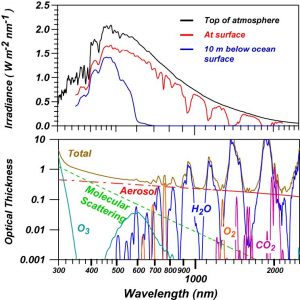Background and History

The Role of the Sun
The Sun is the dominant energy source for the Earth. The next dominant energy source is heat flux from the Earth’s interior, which contributes roughly only 0.03% with respect to the total solar irradiance [Sellers, 1965; Kren et al., 2017]. The Sun varies on timescales ranging from minutes to decades. The dominant cycle in total solar irradiance (TSI) is approximately 11-years in length, with peak-to-peak amplitudes of 0.1%. A visible manifestation of solar variability is the appearance of dark sunspots and bright faculae on the Sun’s surface, which are caused by magnetic phenomena within the Sun that pass across the solar disk as the Sun rotates in an approximate 27-day period, producing larger variations in energy output of roughly 0.2%. Variability also exists at shorter time scales related to eruptive events such as solar flares [Hock, 2012] and at century (and longer) time scales as indirectly evidenced by isotopic tracer proxies such as beryllium [Uroskin, 2013].
Solar energy is distributed across wavelengths spanning gamma rays (10-10 m) through radio waves (> 100 m). However, as shown in Figure 1 roughly 97% of the total solar energy occurs at the ultraviolet (UV), visible, and nearinfrared portions (~200-2400 nm) of the spectrum [Harder et al., 2009]. The relative variability in solar spectral irradiance (SSI: 200-2400 nm) over the solar cycle can span 5 orders of magnitude greatly surpassing the variability in TSI [Harder et al., 2009; Coddington et al., 2016].
Figure 1: The wavelength-dependency of solar radiation at various levels within the Earth system: The dependency is due to the scattering and absorption of the sunlight induced by aerosols, the surface, and vertical profiles of molecular gas species. The strong absorption bands in the infrared are predominantly due to water vapor, with oxygen (O2), carbon dioxide (CO2), and methane also playing a role. The complete extinction of radiation at wavelengths shorter than ~300 nm is due to ozone (O3).
Because of selective absorption and scattering processes in the Earth’s atmosphere, the climate system responds in distinct ways to solar energy inputs in different spectral regions. The Earth’s atmosphere absorbs completely solar radiation in the ultraviolet (UV) spectrum at wavelengths shortward of 315 nm. This radiation becomes the dominant direct energy input to the middle atmosphere and plays a major role in the physical processes there — including the photochemistry, dynamics, temperature, composition and structure. It is critical for both the formation and destruction of ozone. Even small changes in the incoming solar UV radiation produce commensurate changes in middle atmosphere parameters. Longer wavelength visible and near infrared radiation penetrates to the lower atmosphere and to the Earth’s surface. When averaged over the globe, roughly half of the incoming solar radiation is either absorbed in the atmosphere or scattered back into space, the remaining half being absorbed at the surface. Since atmospheric
scattering and absorption processes are all wavelength-dependent, it is essential to understand the variation of the Sun’s radiation as a function of wavelength to properly understand the physical processes by which solar irradiance variability may influence climate. Solar ultraviolet radiation comprises less than 1% of TSI, yet may account for 30% of its 11-year cycle variation. From a combination of observations and model calculations Trenberth et al. [2009], Stephens et al., [2012] and Wild et al. [2013] suggest that approximately 22-23% of the TSI is absorbed principally
by clouds, stratospheric ozone and other minor constituents, and tropospheric water vapor – all processes that are strongly wavelength dependent (see also Figure 1).
To accurately understand the Sun’s role in Earth’s climate, knowledge in both the total energy and its spectral distribution are required. Implications of a solar role are evident in most climate records [Lean et al., 2005]. Two proposed mechanisms of solar variability on climate include the top-down [Gray et al., 2010] and bottom-up [Meehl et al., 2009] mechanisms. In the top-down mechanism, the transfer of energy at ultraviolet wavelengths into the stratosphere impacts the formation of ozone at these altitudes; a process which releases energy into the stratosphere that is transferred to the troposphere by stratospheric-tropospheric coupling [Gray et al., 2010]. In the bottom-up mechanism, localized increases in surface heating (such as cloud-free regions in the subtropical oceans) occur from increases in total solar irradiance at solar maximum conditions and impact the overarching Hadley and Walker circulation cells to ultimately affect winds, clouds, and precipitation patterns.
Evidence suggests that reductions in the Sun’s energy have had a large impact on Earth’s historic climate. A period of time (the Maunder Minimum: 1645-1715) with little to no sunspots and a reduction of solar irradiance by 0.24% [Lean et al., 1995] has been correlated to a time where European winters were much colder and glacial activity progressed further south [Eddy, 1976; Lean and Rind, 1998]. There are various estimates of the increase in TSI from the Maunder Minimum to contemporary times ranging from 0.002% to 0.2% [Feulner, 2011; Judge et al., 2012]. Correlations between surface temperatures and solar activity have decreased in present times, a fact that is thought to be due to the increasing influence of anthropogenic emissions [Reid, 1991, 1997; Lean et al., 1995].

